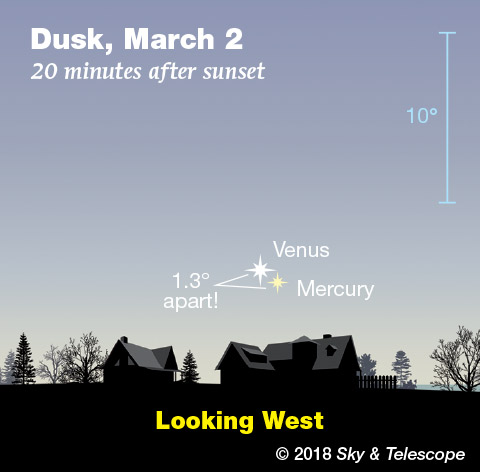
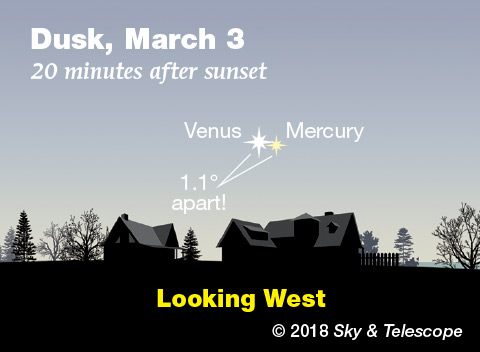
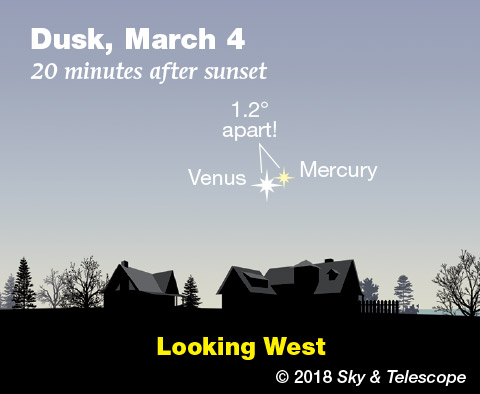
Friday, March 2
• Soon after sunset, use binoculars to start looking for Venus and Mercury together just above the west horizon, as shown here.
• If you're in the longitudes of North America, check in on Jupiter's unusually red Great Red Spot with your telescope before dawn tomorrow morning. The GRS should cross Jupiter's central meridian around 6:12 a.m. EST (3:12 a.m. PST) Saturday morning. Features on Jupiter remain closer to the planet's central meridian than to the limb for nearly an hour before and after they transit.
You'll also find Ganymede's tiny black shadow crossing Jupiter's face from 4:29 to 6:15 a.m. EST (1:19 to 3:15 a.m. PST) Saturday morning.
All of the Great Red Spot's transit times in March (they come about every 10 hours) are listed on page 50 of the March Sky & Telescope. Facing that page is a timetable of all the events involving Jupiter's moons and their shadows.
Saturday, March 3
• Today is when Venus and Mercury appear closest together low in bright twilight, as shown in the middle panel here.
• Now that it's early March, quite soon after dark the Big Dipper stands as high in the northeast as Cassiopeia is in the northwest. Midway between them, as always, is Polaris.
Sunday, March 4
• Have you ever seen Canopus, the second-brightest star after Sirius? In an interesting coincidence, Canopus lies almost due south of Sirius: by 36°. That's far enough south that it never appears above your horizon unless you're below latitude 37° N (southern Virginia, southern Missouri, central California). And there, you'll need a very flat southern horizon. Canopus crosses the south point on the horizon just 21 minutes before Sirius does.
When to look? Canopus is due south when Beta Canis Majoris — Mirzam the Announcer, the star about three finger-widths to the right of Sirius — is at its highest point due south (around 7 or 8 p.m. now, depending on how far east or west you are in your time zone). Look straight down from Mirzam then.
Monday, March 5
• After dark, Orion's near-horizontal Belt points to the right toward orange Aldebaran in the west and, farther on, the little Pleiades star cluster subtly glittering.
You might not guess it now, but the Pleiades are heading down to a twilight rendezvous with Venus in seven weeks. They'll pass each other for a few nights around April 23rd.
Tuesday, March 6
• Jupiter and the waning gibbous Moon rise in company around the middle of the night tonight. By early dawn on Thursday, they hang together in fine view in the south.
Wednesday, March 7
• With the Moon out of the evening sky, this is a fine week to look for the zodiacal light if you live in the mid-northern latitudes — now that the ecliptic tilts high upward from the western horizon at nightfall. From a clear, clean, dark site, look west at the very end of twilight for a vague but huge, narrow pyramid of pearly light. It's very tall and tilted to the left, aligning along the constellations of the zodiac.
What you're seeing is sunlit interplanetary dust, orbiting the Sun near the ecliptic plane. Believe it or not, seen from interstellar distances this would be the solar system's most prominent feature after the Sun itself. The "zodiacal lights" of dust around other stars may be a real obstacle to someday seeing their small, terrestrial planets.
Thursday, March 8
• Orion is starting to tilt westward after dark now. Later in the night, and later in the month, he turns down further, putting his three-star belt into its horizontal springtime position.
• Last-quarter Moon (exact at 6:20 a.m. March 9th EST). The Moon rises around 1 a.m. tonight. In another hour or two once it's high enough, you can see that it's to the right of Antares and above Mars.
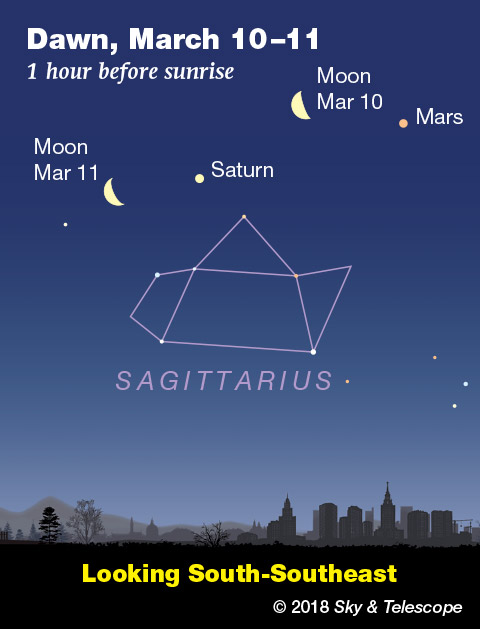
Friday, March 9
• Bright Sirius stands due south on the meridian just after twilight fades away into night. Sirius is the bottom star of the equilateral Winter Triangle. The other two stars of the Triangle are orange Betelgeuse to Sirius's upper right (Orion's shoulder) and Procyon to Sirius's upper left.
• In the early dawn of Saturday, the Moon forms a low, flat triangle with Mars and Saturn, as shown here.
Saturday, March 10
• On the traditional divide between the winter and spring sky lies the dim constellation Cancer. It's between Gemini to its west and Leo to its east. Cancer holds something unique: the Beehive Star Cluster, M44, in its middle.
The Beehive shows dimly to the naked eye if you have little or no light pollution. With binoculars it's easy, even under worse conditions. Look for it a little less than halfway from Pollux in Gemini to Regulus in Leo.
• Daylight-saving time starts at 2 a.m. Sunday morning for most of North America.
________________________
Want to become a better astronomer? Learn your way around the constellations! They're the key to locating everything fainter and deeper to hunt with binoculars or a telescope.
This is an outdoor nature hobby. For an easy-to-use constellation guide covering the whole evening sky, use the big monthly map in the center of each issue of Sky & Telescope, the essential guide to astronomy.

Once you get a telescope, to put it to good use you'll need a detailed, large-scale sky atlas (set of charts). The basic standard is the Pocket Sky Atlas (in either the original or Jumbo Edition), which shows stars to magnitude 7.6.
Next up is the larger and deeper Sky Atlas 2000.0, plotting stars to magnitude 8.5; nearly three times as many. The next up, once you know your way around, is the even larger Uranometria 2000.0 (stars to magnitude 9.75). And read how to use sky charts with a telescope.
You'll also want a good deep-sky guidebook, such as Sue French's Deep-Sky Wonders collection (which includes its own charts), Sky Atlas 2000.0 Companion by Strong and Sinnott, or the bigger Night Sky Observer's Guide by Kepple and Sanner.
Can a computerized telescope replace charts? Not for beginners, I don't think, and not on mounts and tripods that are less than top-quality mechanically (meaning heavy and expensive). And as Terence Dickinson and Alan Dyer say in their Backyard Astronomer's Guide, "A full appreciation of the universe cannot come without developing the skills to find things in the sky and understanding how the sky works. This knowledge comes only by spending time under the stars with star maps in hand."
This Week's Planet Roundup
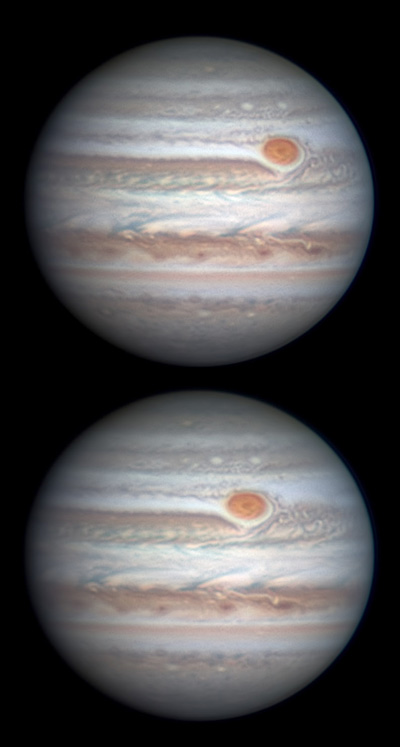
Mercury (about magnitude –1) and much brighter Venus (mag. –4) glow shyly side by side very low in twilight early in the week, then they slowly pull farther apart. They appear closest together on the evening of March 3rd, as shown at the top of this page.
Mars (magnitude +0.7, in the feet of Ophiuchus) rises around 2 a.m. far lower left of Jupiter. Don't confuse Mars with twinklier Antares, which is about 15° to Mars's upper right.
By dawn, Mars and Antares approach the meridian in the south at nearly the same height, forming a gentle arc with Saturn to Mars's left.
Jupiter (magnitude –2.2, in Libra) rises around 11 or midnight to shine as the brightest point in the early-morning sky. Jupiter is at its highest and best for telescopes in the south before the beginning of dawn.
Saturn (magnitude +0.6, above the Sagittarius Teapot) is also a pre-dawn planet. It's about 15° or 20° lower left of Mars, as shown above.
Uranus (magnitude 5.9, in Pisces) is sinking low in the west after nightfall.
Neptune is hidden in conjunction with the Sun.
______________________
All descriptions that relate to your horizon — including the words up, down, right, and left — are written for the world's mid-northern latitudes. Descriptions that also depend on longitude (mainly Moon positions) are for North America.
Eastern Standard Time (EST) is Universal Time (also called UT, UTC, GMT, or Z time) minus 5 hours.
______________________
"The dangers of not thinking clearly are much greater now than ever before. It's not that there's something new in our way of thinking, it's that credulous and confused thinking can be much more lethal in ways it was never before."
— Carl Sagan, 1996
______________________
"Objective reality exists. Facts are often determinable. Vaccines save lives. Carbon dioxide warms the globe. Bacteria evolve to thwart antibiotics, because evolution. Science and reason are not a liberal conspiracy. They are how we determine facts. Civilization's survival depends on our ability, and willingness, to use them."
— Alan MacRobert, your Sky at a Glance editor
______________________
"Facts are stubborn things."
— John Adams, 1770
 1
1








Comments
Roger-Keith
March 3, 2018 at 12:42 am
From outside our solar system, how much of our Zodiacal Light lies beyond our orbit? Out to the asteroid belt?
Best regards -
You must be logged in to post a comment.
You must be logged in to post a comment.